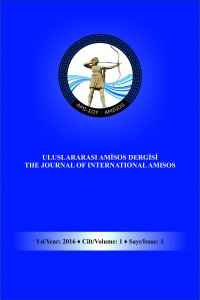Abstract
Achaemenids, which is the world’s biggest empire for more than 200 years between 550 and 331 BC. The main settlement is the territory, which is equal to Persian province today, in the northwest of Persia high plateau, Parsa, in the north of the Persian gulf. The major capitals such as Persepolis, Ecbatana, Susa, Behistun and Babylonia, and the inscriptions found in significant kingdom centers reveal that Achaemenid Kingdom is the heir to thousands-year history of Mesopotamia. We define Late Iron Age (LIA) as a period including the dates of the fall of Urartu and Achaemenid dynasty (645/625-330 BC). It consists of two phases; the first phase known Post-Urartian and Media (645/625-550 BC) and the second phase defined as Pers-Achaemenid domination (550-330 BC). LIA ceramics show peculiar characteristics in surface processing, technic and form. The potteries are the products of a new tradition and culture. Urartu’s monochrome and shiny red lining ceramics give place to a new type of pottery which has got thick cream lining and which can be designed in different forms such as monochrome, bichrom and polychrome. However, we do not know much about the relationships between the end of one’s ceramic tradition and the other’s beginning because of few data between the fall of Urartu state and the period when dyed pottery rises with Achaemenid.
Keywords
Urartian Post-Urartian Media Scythian Cimmerian Achaemenid Eastern Anatolia Satrap Dye-Ornamented Pottery Late Iron Age Triangle Ware Apadana Chronology
References
- CASABONNE, Oliver, “Büyük Kral ve Persler”, ArkeoAtlas, VI, 2007, 20-35.
- DIAKONOFF, Igor M., “Media”, Cambridge Ancient History I, II, 1985, 36-149.
- DYSON, Robert H. Jr., “The Architecture of Hasanlu: Periods I to IV”, American Journal of Archaeology, LXXXI, 1977, 548-552.
- DYSON, Robert H. Jr., “The Achaemenid Painted Pottery of Hasanlu IIIA.”, Anatolian Iron Ages, IV, (Eds. A. Çilingiroğlu-R.J. Matthews), Anatolian Studies, IL, 1999a, 101-110.
- GOPNIK, Hilary, “The Shape of Sherds: Function And Style at Godin II”, Iranica Antiqua, XL, 2005, 249-269.
- HERODOTOS I, Herodot Tarihi, (Çev.: M. Ökmen), İstanbul, 1991.
- HUFF, D., “From Median to Achaemenian Palace Architecture”, Iranica Antiqua, XL, 2005, 371-395.
- KARAOSMANOĞLU, Mehmet, “Altıntepe Kalesi İkinci Dönem Kazıları”, Doğudan Yükselen Işık, Arkeoloji Yazıları. Atatürk Üniversitesi 50. Kuruluş Yıldönümü Arkeoloji Bölümü Armağanı, (Haz.: B. Can-M. Işıklı), Erzurum, 2007, 69-83.
- YİĞİTPAŞA, Davut, “Erzurum Müzesi'nden Bir Grup Geç Demir Çağ Çanak Çömleği”, Uluslararası Van Gölü Havzası Sempozyumu/The Fifth Internarional
- YİĞİTPAŞA, Davut, Doğu Anadolu Geç Demir Çağı Kültürü, Gece Kitaplığı, 2016, Ankara.
Abstract
Achaemenids, which is the world’s biggest empire for
more than 200 years between 550 and 331 BC. The main settlement is the
territory, which is equal to Persian province today, in the northwest of Persia
high plateau, Parsa, in the north of the Persian gulf. The major capitals such
as Persepolis, Ecbatana, Susa, Behistun and Babylonia, and the inscriptions
found in significant kingdom centers reveal that Achaemenid Kingdom is the heir
to thousands-year history of Mesopotamia. We define Late
Iron Age (LIA) as a period including the dates of the fall of Urartu and
Achaemenid dynasty (645/625-330 BC). It consists of two phases; the first phase
known Post-Urartian and Media (645/625-550 BC) and
the second phase defined as Pers-Achaemenid domination (550-330 BC).
LIA ceramics show peculiar characteristics in
surface processing, technic and form. The potteries are the products of a new
tradition and culture. Urartu’s monochrome and shiny red lining ceramics give
place to a new type of pottery which has got thick cream lining and which can
be designed in different forms such as monochrome, bichrom and polychrome.
However, we do not know much about the relationships between the end of one’s
ceramic tradition and the other’s beginning because of few data between the fall
of Urartu state and the period when dyed pottery rises with Achaemenid.
Keywords
Urartian Post-Urartian Media Scythian Cimmerian Achaemenid Eastern Anatolia Satrap Dye-Ornamented Pottery Late Iron Age Triangle Ware Apadana
References
- CASABONNE, Oliver, “Büyük Kral ve Persler”, ArkeoAtlas, VI, 2007, 20-35.
- DIAKONOFF, Igor M., “Media”, Cambridge Ancient History I, II, 1985, 36-149.
- DYSON, Robert H. Jr., “The Architecture of Hasanlu: Periods I to IV”, American Journal of Archaeology, LXXXI, 1977, 548-552.
- DYSON, Robert H. Jr., “The Achaemenid Painted Pottery of Hasanlu IIIA.”, Anatolian Iron Ages, IV, (Eds. A. Çilingiroğlu-R.J. Matthews), Anatolian Studies, IL, 1999a, 101-110.
- GOPNIK, Hilary, “The Shape of Sherds: Function And Style at Godin II”, Iranica Antiqua, XL, 2005, 249-269.
- HERODOTOS I, Herodot Tarihi, (Çev.: M. Ökmen), İstanbul, 1991.
- HUFF, D., “From Median to Achaemenian Palace Architecture”, Iranica Antiqua, XL, 2005, 371-395.
- KARAOSMANOĞLU, Mehmet, “Altıntepe Kalesi İkinci Dönem Kazıları”, Doğudan Yükselen Işık, Arkeoloji Yazıları. Atatürk Üniversitesi 50. Kuruluş Yıldönümü Arkeoloji Bölümü Armağanı, (Haz.: B. Can-M. Işıklı), Erzurum, 2007, 69-83.
- YİĞİTPAŞA, Davut, “Erzurum Müzesi'nden Bir Grup Geç Demir Çağ Çanak Çömleği”, Uluslararası Van Gölü Havzası Sempozyumu/The Fifth Internarional
- YİĞİTPAŞA, Davut, Doğu Anadolu Geç Demir Çağı Kültürü, Gece Kitaplığı, 2016, Ankara.
Details
| Primary Language | English |
|---|---|
| Subjects | Archaeology |
| Journal Section | MAKALELER / ARTICLES |
| Authors | |
| Publication Date | December 21, 2016 |
| Submission Date | November 15, 2016 |
| Acceptance Date | December 27, 2016 |
| Published in Issue | Year 2016 Volume: 1 Issue: 1 |

